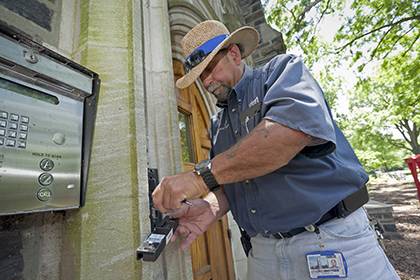New DukeCard System Offers Building Access Consistency
After more than 20 years, the DukeCard system is getting a facelift

Beginning this summer, the university began upgrading its electronic access system. The new system provides more consistency across the university for access to doors and empowers local “facility authorities” within campus departments to manage access to their own buildings.
“In the past, you had to work with the DukeCard office every time you wanted to change a door schedule. If you needed to enable or block access, it meant another call to the DukeCard office,” said Debbie DeYulia, director of customer and technology support.
Read MoreDuke was one of the first universities to install a campus “one-card” system. Today the DukeCard system:
- Produces more than 44,000 new and replacement ID cards per year for students, employees, contractors, summer program/conference attendees, and others.
- Supports more than 1,200 swipe card-controlled and electronic locked doors, including administrative, academic, residence hall, athletic and public-access facilities.
- Processes $20.2 million in Dining Services meal transactions at several dozen locations each year, along with other sales at nearly 750 sites.
The new system was developed in alignment with the campus master plan for safety and security as well as governing principles and policies, including the university’s buildings and facilities access policy. DukeCard users will not need new cards and should see no change in how their cards work.
Individuals are automatically granted access to certain buildings when they join the Duke community. For example, a faculty member may be granted access to the buildings where their department resides, as well as the library. Those buildings are determined dynamically by how they are affiliated with Duke.
For Jason Remhoff, director of finance and administration for Duke TIP, the new system provides the right mix of control, flexibility and security.
“If we hire a new staff member, they’re immediately granted access to our building automatically,” Remhoff said. “For those who aren’t part of our staff but still part of the Duke community, such as Duke postal or housekeeping, granting access takes seconds on the new system. I’ve found it to be very user-friendly.”
The new system also provides more structure for changes in access and temporary access management.
“People work at Duke a long time, and offices move. Transfers typically provided additive access, and there was no regular review, so access in many cases was far broader than needed,” said Leigh Goller, director of Internal Audits.
In future phases of the project, Duke will overhaul its system for financial transactions and event management.
The DukeCard office is working with departments to phase in the new system. The transition is scheduled to be completed by early 2015.